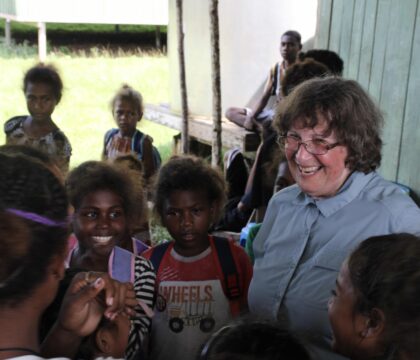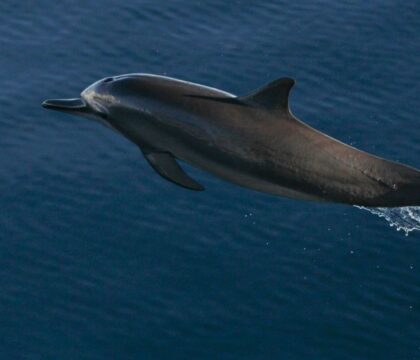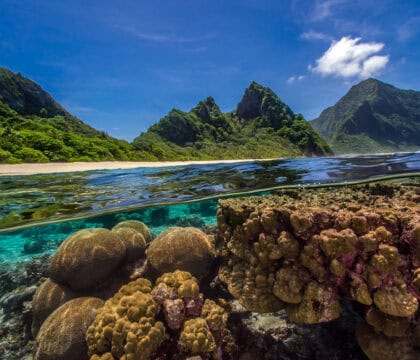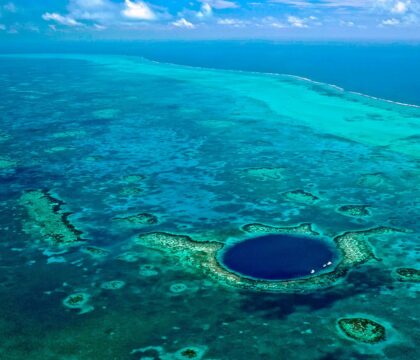May 6, 2016 • Trip Reports
[IMAGE]
“Pilot whales … again!!” exclaimed our captain, Alan, looking out the wheelhouse through his binoculars. The 50 or so black dorsal fins were still far away and “logging” on the surface. Pilot whales are easily disturbed, so I asked Alan to slow the boat down to idle, and soon after our engine was in neutral. With minimal engine noise we could glide in so much closer with minimal impact on the whales’ natural behaviours. And indeed, the pilots stayed on the surface and all around the boat, blowing loudly and spy-hopping their heads out of the water right alongside our vessel, which was now floating in waters 800 m (2,625 ft) deep. Who was looking at whom now? What a spectacular encounter!
We were off the Russell Islands (9ºS / 159ºE), in the remote Solomon Islands, halfway through the Oceanic Society’s 10-day Solomon Islands by Liveaboard expedition. I was onboard the expedition at the invitation of Oceanic Society, who offered to let me use the expedition as a platform to conduct marine mammal surveys. Our group of explorers had just finished an amazing 3-hour snorkel and now it was time for our routine midday-to-3pm “whale patrol.”
[IMAGE]
The Solomon Islands are located in the Southwest Pacific Ocean, a tropical paradise largely forgotten by time itself. The 992 islands that make up this jungle-clad archipelago are located between Papua New Guinea and Vanuatu. This was a remote expedition even by my standards, with hardly any signs of human activity on land, no electricity, and very traditional coastal communities. Wooden canoes with paddles are the main form of local transport in between the islands.
[IMAGE]
The Solomons are also the easternmost part of the so-called Coral Triangle, a region within Asia-Pacific that has the highest marine biodiversity in the world. The Coral Triangle also includes Indonesia, Timor Leste, Malaysia, the Philippines and Papua New Guinea. Culturally, the Solomon Islands are equally diverse and have a unique position in the Pacific, where Melanesia meets Polynesia.
This was my first trip back since 2004, when I was the marine mammal / migratory species scientist for six weeks aboard part of a 2,200 km (1,367 mi) survey led by The Nature Conservancy. This groundbreaking Rapid Ecological Assessment (REA) was crucial to the Solomons, as it confirmed the country’s well-deserved place in the six-nation Coral Triangle Initiative. With Solomon Islands as a new member state, the Coral Triangle became a much bigger “bull’s-eye of marine biodiversity” and expanded eastward into the South Pacific.
[IMAGE]
So it felt special to be back, and it was a privilege to be part of such a great group of kind and enthusiastic people, who all enjoyed the brilliant snorkeling and whale watching and were flexible each day to changing plans (due to weather, or whales sighted). We also appreciated that each day we were making a modest but valuable contribution to the marine conservation of this important yet poorly known region in the Solomon Islands.
The summary below describes the monitoring efforts we were able to undertake during the expedition, though it can’t really do justice to the special encounters and behaviours that we witnessed. But it’s impressive that with limited effort (as the Oceanic Society expedition includes lots of other special activities in a day: snorkeling, birding, traditional village visits, woodcarving markets) we were able to accomplish so much.
[IMAGE]
Our whale survey effort by the numbers:
- Distance covered: >407 kilometers (220.1 nautical miles) of national marine waters
- Island groups visited:
- Guadalcanal
- Florida Islands
- Russel Islands
- Mborokua (Mary) Island
- Southern Marovo Lagoon: Kicha, Bulo, Minjanga Islands
- Average dedicated search effort (“whale patrol”): 3 hours per day
- Total sea time: 28.3 hrs
- Actual search hours: 21.3 hrs
- Whale-watch close-up observation time: 7.0 hrs
Our cetacean sightings:
- Cetacean species positively identified: 6
- Total number of sightings: 14
- Encounter frequency – ranking by species:
- Spotted dolphins (Stenella attenuata; n=2)
- Indo-Pacific bottlenose dolphins (Tursiops aduncus; n=2)
- Pilot whales (Globicephala macrorhynchus; n=2)
- Fraser’s dolphins (Lagenodelphis hosei; n=1)
- Spinner dolphins (Stenella longirostris; n=6)
- Risso’s dolphins (Grampus griseus; n=1)
Note: This may seem like a lot, but this is a minimal count, as we only count whales and dolphins at the surface; no guesswork of how many are underwater! Actual numbers of all animals in the encounters with oceanic cetacean species could be 2-5 times higher, as their ecology includes complex social structures and group compositions.
[IMAGE]
Last but not least: Our contributions to marine conservation
Upon our return to port in Honiara, we had already requested a meeting with the team of the Environment & Conservation Division (ECD), Ministry of Environment, Climate Change, Disaster Management & Meteorology of the Solomon Islands Government.
Oceanic Society travel programs director Wayne Sentman and I were warmly welcomed at the ECD Office and we presented the major outcomes of the trip to all at the Environment & Conservation Division (you can download a PDF of that presentation here). We also invited feedback and discussed some overlapping interests and priorities for cetacean conservation.
Importantly we agreed to work closely together and conduct some joint activities in 2017 and onwards. One idea taking hold right now is to conduct a 2-day training workshop just prior to the 2017 Solomon Islands by Liveaboard Expedition. This hands-on training will boost skills and capacity for whale management in Solomon Islands’ waters. The following rough agenda was discussed:
- Day 1: Cetacean field-orientated training (species identification at sea, ecology, survey and long-term monitoring methods):
- Day 2: Cetacean conservation, threats, management and policy development (incl. Marine Spatial Planning).
Another priority project that we agreed upon was to conduct a cetacean training survey in the eastern provinces of the Solomons, as this region remains one of the least studied areas of the Coral Triangle and the South Pacific! These activities all depend on extra funding. So my next office task for these exciting whale conservation projects will be to write several proposals for fundraising.
It’s been such a success, our first expedition in the Solomon Islands. I can’t wait to expand our program with the Oceanic Society in 2017, to build on what we’ve learned so far about the whales and dolphins of the Solomons, and to assist with hands-on marine mammal conservation in this very special part of the Coral Triangle.
Thank you for your support!
[IMAGE]




